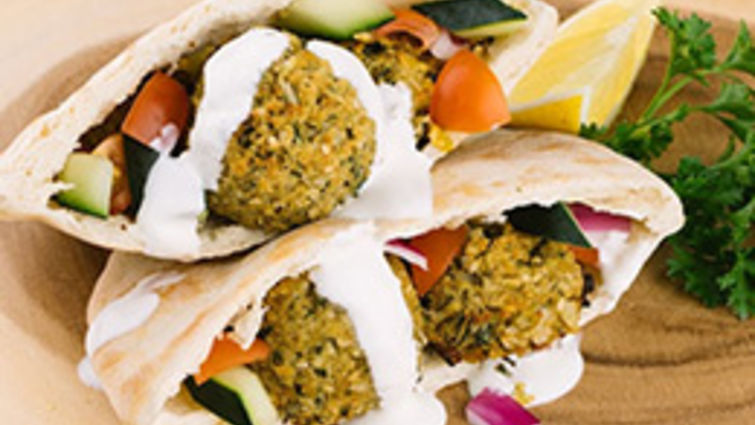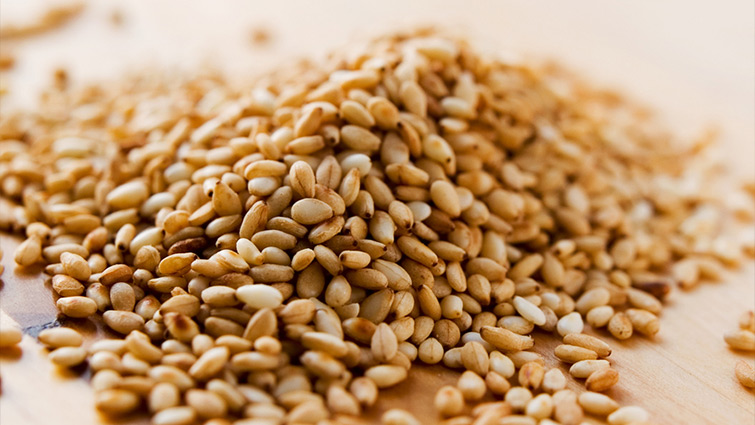A traditional Middle Eastern dish, these tasty falafels go great with pita bread, hummus, or on a bed of greens. Add additional herbs and spices to make your own favorite variety.

Recipe: Our Favorite Falafel
Serving size: 2 balls
Servings per recipe: 6
Prep time: 10 min
Cook time: 15 min
- 1 can - Chickpeas, 15 oz., rinsed, drained and patted dry
- 1/3 cup - Parsley, fresh
- 1/3 cup - Cilantro, fresh
- 4 cloves - Garlic
- 2 ea - Shallots, minced - equivalent to 3/4 cup (can substitute yellow onion)
- 2 Tbsp - Sesame seeds, raw
- 1 1/2 tsp - Cumin, ground (plus more to taste)
- 1 tsp - Coriander
- Pinch - Cayenne pepper
- 3-4 Tbsp - Breadcrumbs (can substitute with an oat flour or gluten-free blend with varied results)
- 3-4 Tbsp - Grapeseed oil for cooking (or replace with a neutral, high smoke point oil)
- OPTIONAL: Breadcrumbs for coating
Directions
Preheat oven to 375°F. Add chickpeas, parsley, cilantro, garlic, shallots, sesame seeds, cumin, coriander and cayenne pepper to a food processor to combine, scraping down sides as needed until combined. You want a crumbly dough, not a paste. Add breadcrumbs one Tbsp at a time and pulse to combine until mixture is no longer wet. You want to be able to touch the dough without it sticking to your fingers.
Move mixture to a mixing bowl, cover and refrigerate 1-2 hours to firm dough up. Once chilled gently form into 12 small patties or balls. OPTIONAL: Sprinkle with bread crumbs and gently press to adhere - flip and repeat. This will produce a crispier crust.
Bake at 3750F for 20-25 minutes, or until firm. Serve warm with a tzatziki sauce, inside a pita with desired toppings or atop a bed of greens.
TIP: Best fresh. Will keep in the refrigerator for several days and frozen for up to one month.
Nutrition Facts
Serving size:
| Calories | 233 |
| Total Fat | 10g |
| Saturated Fat | 1g |
| Monounsaturated Fat | 2g |
| Polyunsaturated Fat | 6g |
| Sodium | 322mg |
| Total Carbohydrate | 30g |
| Protein | 7g |
| Sugar | 7g |

Star Ingredient:
Sesame Seeds Contain:
Copper*
Although we may only need small amounts of this trace mineral, copper is very important to our overall health. The primary function of copper in the body is to serve as a constituent of enzymes with catalyze the formation of hemoglobin, help manufacture the protein collagen, assist in the healing of wounds and help maintain the sheath around nerve fibers. One of copper’s most vital roles is to help cells use iron. Like iron, copper is needed in many reactions related to respiration and energy release. The best food sources include legumes, whole grains, seafood, nuts, and seeds.
Calcium*
You guessed it! Calcium is essential for bone health. As young children, we need it for bone development, and as we age, we need it to maintain the integrity of our bones. Ninety-nine percent of the body’s calcium is stored in the bones where it plays two important roles. First, it is an integral part of bone structure. Second, it serves as a calcium bank available to the body fluids should there be a drop in blood calcium. Calcium is found almost exclusively in a single class of foods, milk and milk products. Among the vegetables, mustard greens, kale, parsley, watercress, and broccoli are good sources of available calcium. Adequate calcium intake during the growing years is essential to achieving optimal bone mass and protection from osteoporosis in later life.
Zinc*
Zinc assists more than 100 enzymes in the reactions affecting growth, vitamin A activity, digestion, and sperm and fetal development. Like iron, zinc absorption is influenced by zinc status; if more is needed, more is absorbed. Protein-rich foods are the best sources of zinc. Fiber and phytates in cereal can bind zinc and limit Zinc absorption.
*These statements have not been evaluated by the Food and Drug Administration. This is not intended to diagnose, treat, cure, or prevent any disease.

